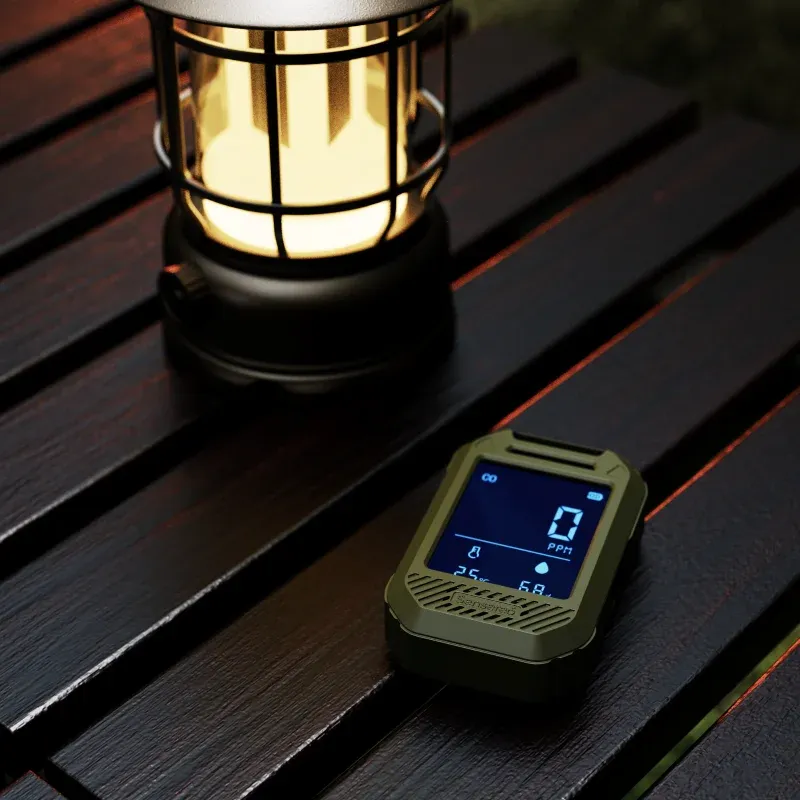Brief Summary:
Traveling can be one of life’s greatest joys, but even a perfect trip can be marred by an invisible, odorless, and potentially deadly threat: carbon monoxide (CO). While we meticulously pack our clothes, toiletries, and chargers, one of the most vital pieces of safety equipment is often forgotten: a portable carbon monoxide detector.
This comprehensive guide is designed to empower you with the knowledge you need to protect yourself and your loved ones on the road. We’ll demystify a common misconception, explain the silent dangers of CO, and help you find the best carbon monoxide detector for your unique travel needs.
The Unseen Threat: Why You Need a Detector for Travel
At home, fire and building codes often require the installation of CO detectors, providing a baseline of safety. However, these regulations do not always extend to hotels, short-term rentals, cabins, or international accommodations.
According to a study cited by the New York Times, over 150 CO-related incidents occur in short-term lodging across the US each year, and that number is likely under-reported. These incidents are not limited to faulty furnaces. They can be caused by a wide range of issues, from a clogged chimney on a gas fireplace to a leaky water heater, or even a car left running in an attached garage.
Because you have no way of knowing whether a rental property has a functioning, up-to-date detector, carrying your own is the only way to guarantee your safety. It’s a small device that provides immense peace of mind.

Is Carbon Monoxide Heavier Than Air?
One of the most persistent and dangerous myths about carbon monoxide is that it is heavier than air and sinks to the ground. This has led many people to incorrectly place their detectors low on a wall or on the floor.
The truth is, carbon monoxide is slightly lighter than air. Its relative density is about 0.967, compared to air’s 1.0. However, this minor difference is largely insignificant in real-world conditions. CO gas mixes readily with the air in a room and can be found throughout the space.
For this reason, safety experts and organizations like the National Fire Protection Association (NFPA) recommend placing CO detectors at chest level or higher on a wall, or on the ceiling. When traveling, a bedside table or a shelf near your sleeping area is the ideal spot. This ensures the detector can sense the gas regardless of air movement or temperature, providing the earliest possible warning.

Key Features of the Best Carbon Monoxide Detector for Your Travels
Not all CO detectors are created equal, and the features that make a great home detector may not be as crucial for a travel-specific device. When shopping for a portable carbon monoxide detector, prioritize these key features:
- Sensor Technology: The most important component of any detector is its sensor. Look for a device with an electrochemical sensor. This technology is the industry standard for accuracy and reliability. Unlike older, less sensitive sensors, an electrochemical sensor provides a more precise and consistent reading of CO levels.
- Low-Level Alarming: This is perhaps the most critical difference between a home and a travel detector. Most home detectors are certified to UL 2034 standards, which means they are not required to alarm until CO levels reach 70 ppm and have been present for at least 60 minutes. While this is a good standard for preventing fatalities, it’s not ideal for preventing illness. Early exposure to even low levels of CO (as little as 9 ppm) can cause symptoms like headaches, dizziness, and fatigue. For this reason, the best carbon monoxide detector for travel will have a low-level alarming protocol, alerting you to dangerous conditions before they have a chance to make you sick.
- Power Source and Battery Life: Portability demands a reliable power source. You have a few options:
- Sealed-in 10-Year Sensor:Many modern detectors, like the Sensereo C-1, feature a 10-year sensor lifespan. The device is powered by replaceable AA batteries with a 5-year life, making it a convenient and long-lasting choice for home or travel.
- Replaceable Batteries:Some models use common batteries like AA or AAA. While convenient, this requires you to keep an eye on the battery level and have replacements on hand.
- Rechargeable:Certain high-end portable detectors can be recharged via USB. This is a great option, but remember to pack the charging cable and ensure you have access to a power source.
- Plug-In with Battery Backup:Some models are designed to plug into a wall outlet, but also have a battery backup. This is a good hybrid option, especially for hotel stays, but may be less convenient for camping or RV travel where outlets are scarce.
- Digital Display: A digital screen that shows the current CO level in parts per million (PPM) is an invaluable feature. It allows you to monitor the environment and see if CO levels are rising, giving you a chance to investigate and take action before the alarm even sounds. This is far superior to devices that only have a simple “green light for go” and an alarm for danger.
- Loud Alarm and Voice Alerts: The alarm should be loud enough to wake you from a deep sleep, especially in an unfamiliar environment. An alarm that reaches 85 dB is the standard. Some of the best carbon monoxide detector models also use voice alerts that announce the type of hazard, which can be less jarring and more informative during an emergency.
- Certifications: To ensure a device is reliable, always look for certifications from reputable third-party organizations, such as CE certification. A CE-marked detector has been tested and verified to meet stringent safety, health, and environmental standards for products sold in the European Economic Area (EEA). Be wary of uncertified devices found online that may not meet the safety requirements of your country.
- TSA-Friendly: Most portable carbon monoxide detectors are considered personal electronic devices and are allowed in both carry-on and checked luggage. However, if the device has a removable lithium battery, it may be subject to additional restrictions and should be placed in your carry-on luggage. It’s always a good idea to check with your specific airline and the TSA guidelines before flying.
Real-World Scenarios: Where a Portable Detector Is a Lifesaver
A travel carbon monoxide detector is a valuable addition to your packing list in a surprising number of scenarios:
- Hotel Stays: While many hotel chains are starting to install detectors, they are not universally required. A CO leak from a boiler room or a faulty gas appliance in a neighboring room could pose a risk.
- Vacation Rentals (Airbnbs, VRBOs): These properties are often not subject to the same safety codes as commercial hotels. A faulty furnace or a gas stove can be a hidden danger.
- Cabins and Hunting Lodges: Many of these off-the-grid locations rely on older heating systems, wood stoves, or portable generators, all of which are potential sources of CO.
- RV and Boating Trips: The exhaust from a motor or generator can easily seep into the living space of an RV or boat, especially in a closed environment.
- Camping: Using a gas lantern or a camping stove inside a tent or other enclosed space is extremely dangerous and can lead to a rapid buildup of CO.
FAQs
Q: Where should I place the detector in a hotel room?
A: Place it on a bedside table, a nightstand, or a shelf near your head. This ensures the alarm is close to you while you sleep. Do not place it on the floor, as CO mixes evenly with air.
Q: Should You Take a Carbon Monoxide Detector When You Travel?
A: Yes! Your safety at home is often protected by building codes and regulations requiring CO detectors. But when you travel, those protections are not guaranteed. Hotels, vacation rentals, cabins, and even campgrounds can have inconsistent or non-existent safety standards.
Q: Are Travel Carbon Monoxide Detectors TSA Approved?
A: Yes, you can generally take a travel carbon monoxide detector on a plane. The Transportation Security Administration (TSA) allows these devices in both carry-on and checked baggage.
Q: Can a CO detector go off if there’s no leak?
A: False alarms can happen, but they are rare. If your detector goes off, open all windows and doors to ventilate the area and get to fresh air immediately. Do not ignore the alarm.
Final Thoughts on Safety and Peace of Mind
Your safety is not something to take for granted. By understanding the nature of carbon monoxide and investing in the best carbon monoxide detector for your needs including a portable carbon monoxide detector for your travels you are taking a proactive step toward protecting yourself and your loved ones from this invisible threat. A small investment can make the difference between a minor inconvenience and a tragic outcome.
Ready to pack a powerful tool for your peace of mind?
Make a portable carbon monoxide detector a permanent part of your packing list. To explore our full range of safety solutions designed for both home and travel, visit us today.
Reference:
https://www.nfpa.org/education-and-research/home-fire-safety/carbon-monoxide




